
E-mail: font@focusonnature.com
Phone: Toll-free in USA 1-800-721-9986
or 302/529-1876
 |
PO
Box 9021, Wilmington, DE 19809, USA E-mail: font@focusonnature.com Phone: Toll-free in USA 1-800-721-9986 or 302/529-1876 |
THE FOCUS ON NATURE TOUR IN COSTA RICA
February 2011
"With over 300 species of birds, and many of them colorful"

The male Flame-colored Tanager
was one of the colorful birds we enjoyed
in southern Costa Rica in February 2011
Links:
List of Birds during the FONT Costa Rica Tour in February 2011
A Complete List of Costa Rica Birds
Upcoming FONT Birding & Nature Tours in Costa Rica
The following, relating to the FONT
February 2011 Costa Rica Tour, was
written by Armas Hill, the tour leader:
Certainly among the birds with
color during our Costa Rica Tour in February 2011 were
the tanagers, toucans, trogons, oropendolas, orioles,
manakins, and the hummingbirds.
They were in addition to our "significant four": the Resplendent
Quetzal, Three-wattled Bellbird, Turquoise Cotinga, and Scarlet Macaw.
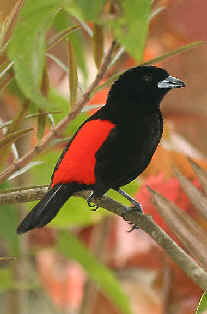
Passerini's Tanager
Among the Tanagers, with brilliant red were both the Passerini's and the
Cherrie's. When those two were, a few years ago, said to be the same
species, they went by the name of Scarlet-rumped Tanager.
Another member of the same family that we saw with bright red and black was the Crimson-collared
Tanager.
With a few bright colors, there was the Golden-hooded Tanager. Golden is
just one of its colors. Bright blue is another.
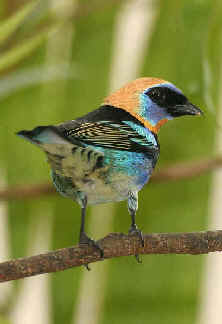
Golden-hooded Tanager
The Spangle-cheeked, Silver-throated, Speckled, and Bay-headed
Tanagers were also nice for us to see. As of course was the Flame-colored
Tanager, with the male as bright as its name implies.
Also nice to watch were brightly-colored birds that were once considered
tanagers, the Euphonias: the Spot-crowned, Yellow-crowned, Yellow-throated,
Tawny-capped, and the Scrub.

Yellow-crowned Euphonia
And, there were some species closely related to the tanagers: the Green Honeycreeper,
Shining Honeycreeper, Red-legged Honeycreeper, Blue Dacnis,
and the Scarlet-thighed Dacnis.

Green Honeycreeper
Colorful thighs are also in the name of another bird that we enjoyed seeing, the Yellow-thighed Finch. Bright yellow those thighs were.
"Yellow-thighed" is also part of
a former name of one of the
colorful manakins that we saw. What is now called the Red-capped
Manakin has also had the name Yellow-thighed Manakin.
With whatever name, the male of that species was fascinating to watch as he
stood diagonally on a branch up above us, stiffly inclined downward at a
45-degree angle, and with his legs enclosed in their yellow "drawers",
as he hitched himself along the branch sideways with his tail leading the way,
rather like the moving cartridge of a typewriter (for those of us who
remember what a typewriter is). As it went, the bird did wing flicks and
made clacking sounds. This behavior that we witnessed has also given the Red-capped
Manakin another name, "el stenografo".
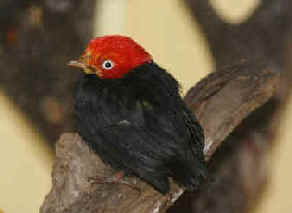
The male Red-capped Manakin
Unfortunately, the bright yellow thighs
are not visible in this photo.
Other colorful Manakins that we saw were the White-collared and
the Blue-crowned.
Two of the three manakins during our tour were in the forest of the
property in southern Costa Rica where the renowned naturalist Alexander Skutch
once lived. The name of that property has been, and continues to be, "Los
Cosingos", the Costa Rican name for the Fiery-billed Aracari,
another downright colorful bird, as are others in that tribe that we saw: the Keel-billed
Toucan, Chestnut-mandibled Toucan, Collared Aracari, and Emerald
Toucanet.
The Aracari may be "Fiery-billed", but one of the Hummingbirds
during our tour was the Fiery-throated.
One of the Warblers during our tour was the Flame-throated.
In all, we saw 25 species of hummingbirds during our February 2011 Costa
Rica Tour. Maybe the most notable of them was the smallest, the Black-crested
Coquette. During our 30 tours in Costa Rica over the years, that species had
previously been seen only once.
Other notable hummingbirds included the Black-bellied Hummingbird,
the Magenta-throated Woodstar, and the Volcano Hummingbird whose
gorget appears like lava flowing from a volcano.
Among the larger of our hummingbirds were these colorful creatures: the Violet
Sabrewing, the Violet-crowned Woodnymph, the Magnificent
Hummingbird, and the Green Hermit.
The Coppery-headed Emerald is one of only 4 species of birds endemic to
Costa Rica (out of 866 that been observed in the country). Another Costa Rican
endemic that we saw was the hummingbird called the Gray-tailed Mountain-gem.
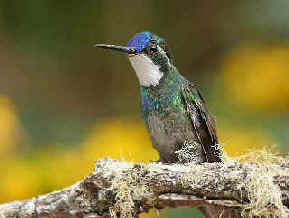
A male Gray-tailed Mountain-gem
Among the 300-plus species of birds during our 2 weeks in mostly the highlands of Costa Rica, there were also these deserving mention: Black Guan, Black-breasted Wood Quail, Boat-billed Heron, Laughing Falcon (seen as it was calling), Swallow-tailed Kite, White Hawk, Southern Lapwing, Chiriqui Quail-Dove, Sulphur-winged Parakeet, a Ferruginous Pygmy Owl seen late in the afternoon, a Black-and-white Owl seen early in the morning, Blue-crowned Motmots, Turquoise-browed Motmot, Rufous-tailed Jacamar, Olivaceous Piculet, Ochraceous Pewee, Fork-tailed Flycatchers, White-throated Magpie-Jay (literally with us one morning at breakfast, ready to take jam-covered toast off the table), 4 species of nightingale-thrushes, American Dipper and Torrent Tyrannulet along rushing streams, the tame Collared Whitestart (as it is tame, also known aptly as the "amigo de hombre", or "friend of man"), Black-cheeked Warbler, Volcano Junco, Sooty-capped Bush Tanager (a favorite), Large-footed Finch, and Black-faced Grosbeak.
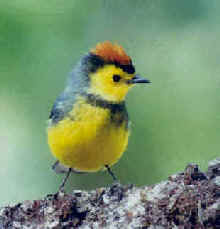
Collared Whitestart
Costa Rican birdlife has changed since our first tour years ago. With the
clearing of forests, some birds, such as some parrots and parakeets
have spread. Others have disappeared or nearly so. Some are more common, some
less so.
The Southern Lapwings that we saw (a pair in northern Costa Rica, near
Arenal) were not in Costa Rica until recently. The species is spreading
north, as is the Red-breasted Blackbird. Spreading south is the Melodious
Blackbird. We saw that species about as far south as one can be in Costa
Rica, near Panama.
In addition to birds during our tour, there was other nature ranging from crocodiles
to leaf-cutter ants. There were many butterflies, most notably
large groups of daggerwings and other puddling by streams. Blue
Morphos flew along forest paths.
The nature overall, including the birds, butterflies, mammals, and more, along
with the spectacular scenery and special places, and of course the people, made
our 30th tour in Costa Rica a memorable
one.
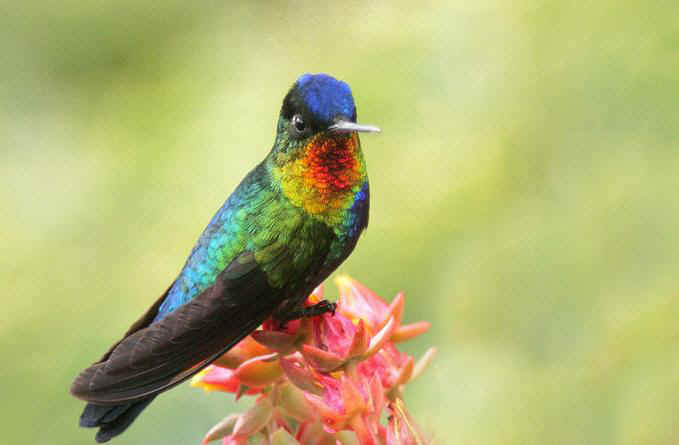
The Fiery-throated Hummingbird
There certainly is color in this bird!